How to stop car rust?
Car rust is a common problem that can affect the appearance, performance, and value of your vehicle. Rust is caused by the chemical reaction of iron and oxygen in the presence of water or moisture. It can damage the metal parts of your car and make them weak, brittle, and prone to corrosion. Rust can also spread quickly and affect other areas of your car if left untreated.
To stop car rust, it’s essential to regularly wash and wax your vehicle to remove dirt, grime, and moisture that can contribute to rust formation. Additionally, promptly repair any scratches, dents, or chips in the paint to prevent moisture from reaching the metal surface. Applying a rust inhibitor or rust-proofing coating can provide an extra layer of protection against corrosion.
Finally, storing your car in a dry, covered area when not in use can help minimize exposure to moisture and prolong its lifespan. Fortunately, there are ways to prevent car rust and protect your vehicle from corrosion.
In this article, we will cover the following topics:
- The importance of preventing car rust
- Understanding the causes of car rust
- Signs of car rust and corrosion
- Steps to stop car rust
- Tips for protecting your vehicle from corrosion
- Best practices for winter car care
- DIY methods for preventing car rust
- Professional services for rust prevention and repair
- Frequently asked questions about car rust prevention
- Conclusion: Maintaining a rust-free vehicle
Adam’s Iron Remover (16oz) – Iron Out Fallout Rust Remover Spray for Car Detailing | Remove Iron Particles in Car Paint, Motorcycle, RV & Boat | Use Before Clay Bar, Car Wax or Car Wash
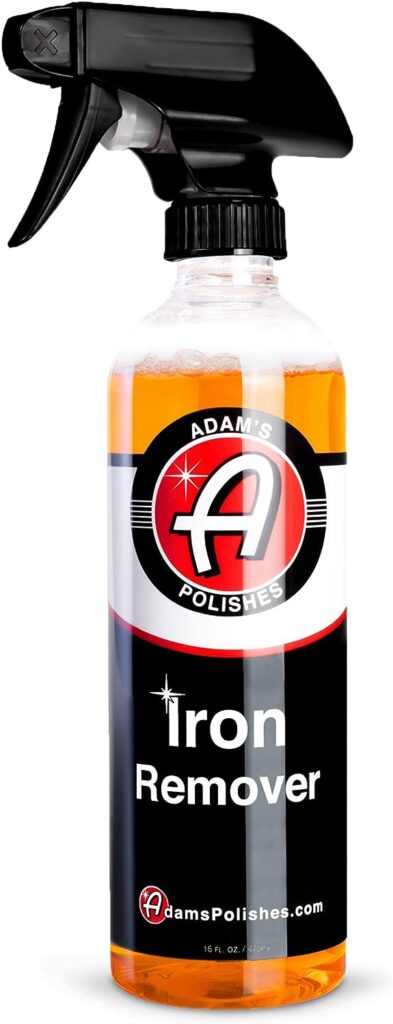
The importance of preventing car rust
Preventing car rust is important for several reasons.
First, rust can affect the aesthetic appeal of your car and lower its resale value.
A rusty car can look old, dirty, and unattractive.
Second, rust can compromise the structural integrity and safety of your car.
Rust can weaken the metal components of your car and make them more susceptible to breaking, cracking, or collapsing.
This can pose a risk to you and your passengers in case of an accident or collision.
Third, rust can impair the functionality and efficiency of your car.
Rust can interfere with the electrical, mechanical, and hydraulic systems of your car and cause them to malfunction or fail.
This can result in poor performance, increased fuel consumption, and higher repair costs.
Therefore, stop car rust is essential for preserving the beauty, durability, and reliability of your car.
By taking proper care of your car and following some simple tips, you can prevent car rust and keep your vehicle in good shape for a long time.
Understanding the causes of car rust
To prevent car rust, you need to understand what causes it and how it develops.
Car rust is the result of a chemical process called oxidation, which occurs when iron (or steel) reacts with oxygen in the presence of water or moisture.
This reaction produces a reddish-brown substance called iron oxide, or rust.
Rust can form on any metal part of your car that is exposed to air and water, such as the body, the frame, the undercarriage, the wheels, the exhaust system, the engine, and the brakes.
There are several factors that can accelerate the formation and spread of car rust, such as:
- Salt: Salt is one of the main enemies of your car, especially in winter. Salt is used to melt snow and ice on the roads, but it can also stick to your car and create a corrosive environment. Salt can lower the pH of water and make it more acidic, which increases the rate of oxidation. Salt can also scratch the paint and clear coat of your car and expose the metal underneath to rust.
- Rain: Rain can also contribute to car rust, especially if it is acidic. Acid rain is caused by the pollution of the atmosphere by sulfur dioxide and nitrogen oxides, which form acids when they mix with water. Acid rain can damage the protective layer of your car and make it more vulnerable to rust. Rain can also collect in the crevices and gaps of your car and create pockets of moisture that can promote rusting.
- Scratches are another common cause of car rust. They can result from accidents, vandalism, debris, or careless parking. Scratches remove the protective paint and clear coat, exposing bare metal to air and water, which accelerates rust formation. Additionally, scratches create crevices that trap dirt and moisture, promoting rust. Regularly repairing scratches and applying protective coatings are essential steps to stop car rust.
- Negligence: Negligence is perhaps the most avoidable cause of car rust. Neglecting to wash, clean, and maintain your car regularly can lead to the accumulation of dirt, dust, mud, and other contaminants that can damage your car and cause rust. Neglecting to inspect, repair, and treat your car for rust can also allow it to spread and worsen over time.
Adam’s 5 Gallon Bucket-O-Towels (67pk) – Variety Car Detailing Bucket of Premium Microfiber Towels for Car Wash, Cleaning, Polishing, Car Wax, Ceramic Coating, Shop Towels & More
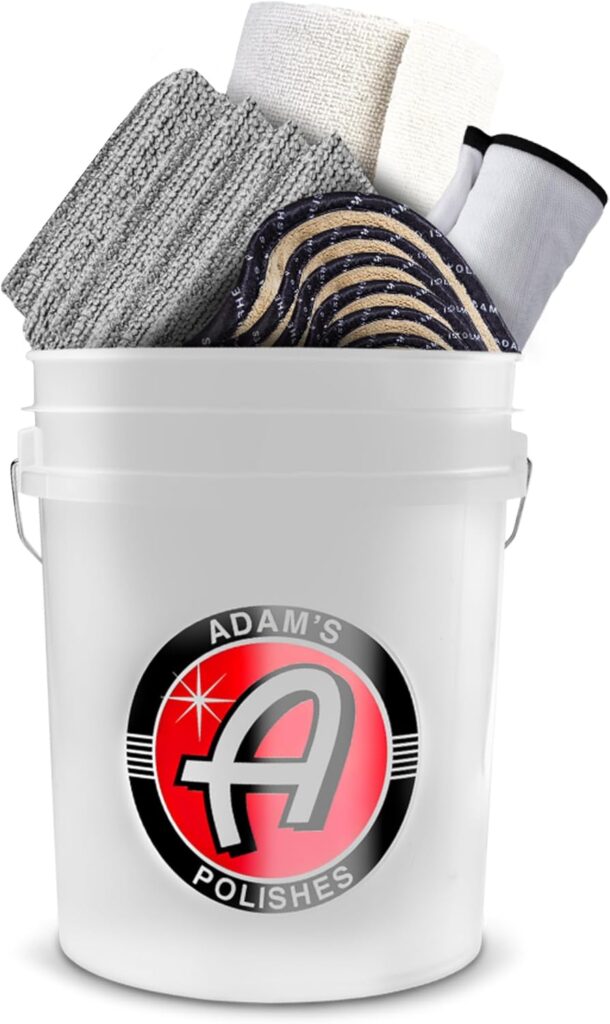
Signs of car rust and corrosion
Car rust and corrosion can be easy to spot if you know what to look for. Some of the common signs of car rust and corrosion are:
- Blisters, bubbles, or flakes on the paint: These are indications that rust is forming underneath the paint and pushing it outward. They can appear on any part of your car, but they are more likely to occur on the lower parts, such as the doors, the fenders, the rocker panels, and the wheel wells.
- Discoloration or stains on the paint: These are signs that rust is affecting the color and quality of your paint. They can appear as brown, orange, yellow, or white spots or streaks on your car. They can also indicate that water or salt has penetrated the paint and reached the metal.
- Holes or cracks on the metal: These are signs that rust has eaten away the metal and created gaps or openings on your car. They can appear on any part of your car, but they are more common on the undercarriage, the exhaust system, the brake lines, and the fuel tank.
- Loose or detached parts: These are signs that rust has weakened the metal and caused it to break or fall off. They can affect any part of your car, but they are more serious on the structural and functional parts, such as the frame, the suspension, the steering, and the engine.
If you notice any of these signs of car rust and corrosion on your car, you should take action as soon as possible to stop it from spreading and causing more damage.
Steps to stop car rust
Stopping car rust is possible if you follow some simple steps. Here are the main steps to stop car rust:
Regular car maintenance
Regular car maintenance is the first and most important step to stop car rust.
By keeping your car in good condition, you can prevent many of the factors that cause rust and corrosion.
You should follow the recommended maintenance schedule for your car and perform the necessary checks, adjustments, replacements, and repairs. Some of the key maintenance tasks that can help prevent car rust are:
- Changing the oil and filter: This can help keep your engine clean and lubricated and prevent rust from forming inside it.
- Checking and topping up the fluids: This can help keep your car running smoothly and prevent leaks that can cause rust on the metal parts.
- Replacing the air filter: This can help prevent dust and dirt from entering your engine and causing rust on the metal parts.
- Replacing the spark plugs and wires: This can help prevent misfires and poor combustion that can cause rust on the exhaust system.
- Replacing the brake pads and rotors: This can help prevent brake dust and friction that can cause rust on the brake system.
- Replacing the tires and wheels: This can help prevent punctures and damage that can cause rust on the wheel wells and the undercarriage.
Washing and cleaning your car to stop car rust
Washing and cleaning your car is another essential step to stop car rust.
By keeping your car clean, you can remove the dirt, dust, mud, salt, and other contaminants that can damage your car and cause rust.
You should wash and clean your car regularly, especially after driving on salted roads, rainy days, or dusty areas.
You should also use the right products and techniques to wash and clean your car properly. Some of the tips for washing and cleaning your car are:
- Use a mild car shampoo and a soft sponge or cloth to wash your car. Avoid using harsh detergents, abrasive materials, or high-pressure washers that can scratch or damage your car.
- Rinse your car thoroughly with clean water to remove all the soap and dirt. Make sure to rinse the undercarriage, the wheel wells, and the bumpers as well, as these are the areas where salt and moisture can accumulate and cause rust.
- Dry your car with a microfiber towel or a chamois to prevent water spots and streaks. Do not leave your car wet or damp, as this can promote rusting.
- Wax your car with a quality car wax to protect your paint and clear coat from the elements. Wax can create a barrier that can repel water, salt, and dirt and prevent them from reaching the metal. Wax can also enhance the shine and appearance of your car.
- Vacuum your car interior and trunk to remove any dirt, dust, or debris that can cause rust on the metal parts. Pay attention to the carpets, the seats, the floor mats, and the crevices where water or spills can seep in and cause rust.
- Polish your car chrome and metal parts with a metal polish to restore their luster and prevent rust. Metal polish can remove any oxidation, tarnish, or corrosion that can affect the metal parts and make them susceptible to rust.
Applying rust prevention products to stop car rust
Applying rust prevention products is another effective step to stop car rust.
By using rust prevention products, you can add an extra layer of protection to your car and prevent rust from forming or spreading.
There are different types of rust prevention products that you can use, depending on the area and the condition of your car. Some of the common rust prevention products are:
- Rust converter: This is a product that can convert existing rust into a stable and inert substance that can prevent further rusting. Rust converter can be applied to any rusty surface with a brush or a spray. It can also act as a primer that can prepare the surface for painting.
- Rust inhibitor: This is a product that can prevent rust from forming on new or bare metal surfaces. Rust inhibitor can be applied to any metal surface with a brush or a spray. It can create a protective coating that can seal the metal from air and moisture and prevent oxidation.
- Rust encapsulator: This is a product that can prevent rust from spreading on existing rusted surfaces. Rust encapsulator can be applied to any rusted surface with a brush or a spray. It can create a flexible and durable coating that can isolate the rust from the surrounding metal and prevent further corrosion.
- Undercoating: This is a product that can prevent rust from forming on the undercarriage of your car. Undercoating can be applied to the underside of your car with a spray gun or a aerosol can. It can create a thick and rubbery coating that can protect the metal from road salt, water, gravel, and other debris that can cause rust.
- Anti-corrosion spray: is a vital tool in the battle against car rust. This product forms a protective barrier on electrical and mechanical components, including battery terminals, wiring, connectors, switches, sensors, bolts, and nuts. By creating a thin, transparent coating, it effectively lubricates and insulates metal surfaces, shielding them from moisture and corrosion. Regular application of anti-corrosion spray helps prevent rust formation and extends the lifespan of your vehicle. With its ability to halt the destructive effects of oxidation, this spray is a crucial element in any comprehensive rust prevention strategy for your car.
- Applying rust prevention products is another effective step to stop car rust. By using rust prevention products, you can add an extra layer of protection to your car and prevent rust from forming or spreading. There are different types of rust prevention products that you can use, depending on the area and the condition of your car. Some of the common rust prevention products are rust inhibitors, rust-resistant coatings, and corrosion-resistant sprays. Anti-corrosion spray is another valuable option. It can prevent rust from forming on the electrical and mechanical parts of your car, including battery terminals, wiring, connectors, switches, sensors, bolts, nuts, and other metal components. This spray creates a thin and transparent coating, effectively lubricating and insulating the metal from moisture and corrosion, thus helping to stop car rust.
Repairing existing rust damage to stop car rust
Repairing existing rust damage is another crucial step to stop car rust.
By fixing the rusted areas of your car, you can restore the appearance, performance, and value of your vehicle.
You should inspect your car regularly for any signs of rust and corrosion and take action as soon as possible to repair them. You should also use the right tools and techniques to repair the rust damage properly.
Some of the tips for repairing existing rust damage are:
- Remove the rust: This is the first step to repair the rust damage. You need to remove the rust from the affected area using a wire brush, a sandpaper, a grinder, or a drill. You need to remove as much rust as possible until you reach the clean and solid metal. You also need to remove any loose or flaking paint around the rusted area.
- Apply the filler: This is the second step to repair the rust damage. You need to apply a filler to the rusted area using a putty knife, a spatula, or a filler gun. You need to use a suitable filler for your car, such as a body filler, a fiberglass filler, or a metal filler. You need to apply the filler evenly and smoothly over the rusted area and let it dry and harden.
- Sand the filler: This is the third step to repair the rust damage. You need to sand the filler using a sandpaper, a sander, or a sanding block. You need to sand the filler until it is smooth and level with the surrounding metal. You also need to sand the edges and corners of the filler to blend them with the metal.
- Prime the area: This is the fourth step to repair the rust damage. You need to prime the area using a spray gun, a aerosol can, or a brush. You need to use a suitable primer for your car, such as a rust-inhibiting primer, a self-etching primer, or a high-build primer. You need to apply the primer evenly and lightly over the area and let it dry and cure.
- Paint the area: This is the fifth and final step to repair the rust damage. You need to paint the area using a spray gun, a aerosol can, or a brush. You need to use a suitable paint for your car, such as a base coat, a clear coat, or a touch-up paint. You need to match the color and finish of your car as closely as possible. You need to apply the paint evenly and lightly over the area and let it dry and cure.
Rust-Oleum 248658 Rust Reformer Spray, 10.25 oz, Black
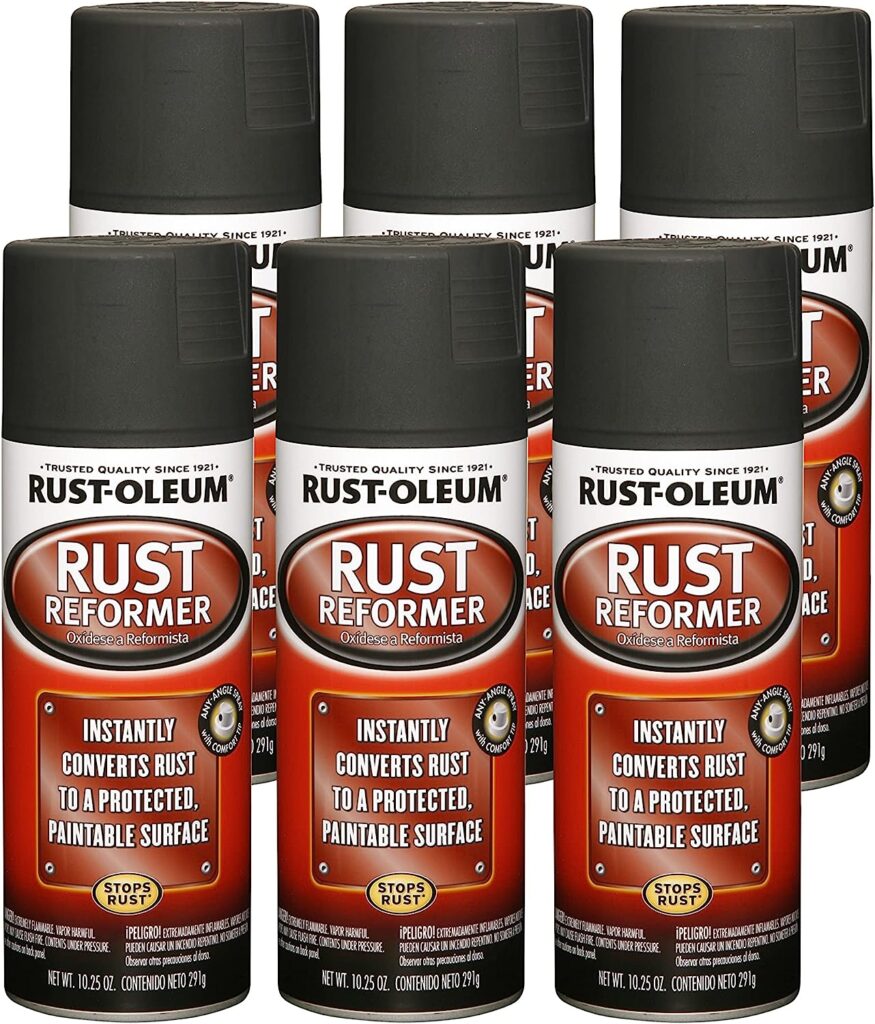
Tips for protecting your vehicle from corrosion
Protecting your vehicle from corrosion is another important aspect of preventing car rust.
By following some simple tips, you can reduce the risk of corrosion and extend the life of your car.
Some of the tips for protecting your vehicle from corrosion are:
- Park your car in a garage or a covered area: This can help protect your car from the sun, the rain, the snow, and the wind that can cause corrosion. If you do not have a garage or a covered area, you can use a car cover or a tarp to shield your car from the elements.
- Avoid driving on salted roads or near the ocean: This can help prevent your car from being exposed to salt and moisture that can cause corrosion. If you have to drive on salted roads or near the ocean, you should wash and rinse your car as soon as possible to remove the salt and the water.
- Avoid parking on grass or dirt: This can help prevent your car from being exposed to moisture and bacteria that can cause corrosion. If you have to park on grass or dirt, you should move your car frequently and check the undercarriage for any signs of rust or corrosion.
- Avoid spilling liquids or food on your car: Prevent exposure to acids and sugars that cause corrosion. Clean spills immediately and dry the area thoroughly to stop car rust.
Best practices for winter car care
Winter car care is another essential factor for preventing car rust.
By taking care of your car during the cold and snowy season, you can prevent the damage and deterioration that can occur due to the harsh weather conditions.
Some of the best practices for winter car care are:
- Check your battery: This can help prevent your car from being stranded or unable to start due to a dead or weak battery. You should check your battery for any signs of corrosion, leakage, or damage and replace it if necessary. You should also keep your battery fully charged and clean the terminals and cables regularly.
- Check your tires: Regular checks prevent traction loss or skidding from low or uneven tire pressure. Look for signs of wear, tear, or damage, replacing tires as needed. Keep them properly inflated, aligned, and rotate them to stop car rust.
- Check your windshield wipers and fluid: This can help prevent your car from having poor visibility or freezing due to snow, ice, or frost. You should check your windshield wipers for any signs of wear, tear, or damage and replace them if necessary. You should also keep your windshield fluid full and use a winter-grade fluid that can resist freezing.
- Check your antifreeze and coolant: This can help prevent your car from overheating or freezing due to extreme temperatures. You should check your antifreeze and coolant for any signs of contamination, leakage, or damage and replace them if necessary. You should also keep your antifreeze and coolant full and use a 50/50 mix of antifreeze and water.
- Check your lights and signals: This can help prevent your car from having poor visibility or being unnoticed by other drivers due to dim or broken lights and signals. You should check your lights and signals for any signs of malfunction, damage, or burnout and replace them if necessary. You should also keep your lights and signals clean and clear of snow and ice.
Sonax (288200-755) High Speed Wax – 16.9 fl. oz., Red
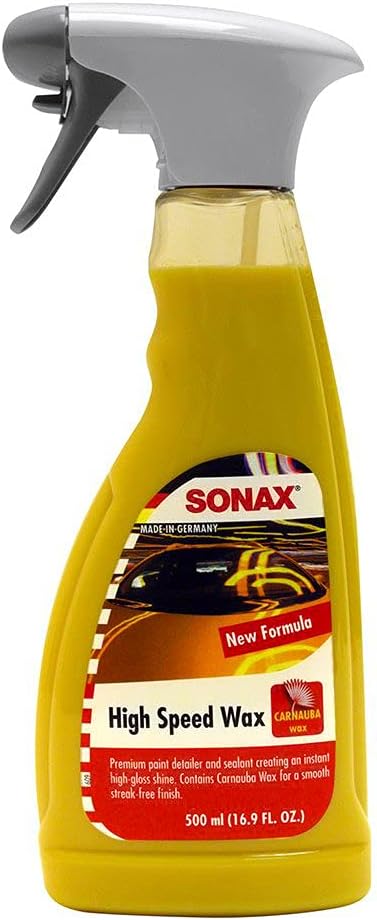
DIY methods for Stop car rust
Preventing car rust can also be done by using some DIY methods that can be cheap and easy to do.
By using some household items or natural ingredients, you can create your own rust prevention products and apply them to your car.
Some of the DIY methods for preventing car rust are:
- Vinegar: This is a natural acid that can dissolve rust and prevent it from forming. You can use vinegar to clean and treat any rusty areas on your car. You can also mix vinegar with water and spray it on your car to create a protective layer that can repel rust.
- Baking soda: This is a natural base that can neutralize rust and prevent it from spreading. You can use baking soda to scrub and remove any rust on your car. You can also mix baking soda with water and apply it on your car to create a protective layer that can resist rust.
- Lemon juice: This is a natural acid that can remove rust and prevent it from forming. You can use lemon juice to clean and treat any rusty areas on your car. You can also mix lemon juice with salt and apply it on your car to create a protective layer that can prevent rust.
- Petroleum jelly: A natural lubricant that seals and protects metal from rust. Apply it to rust-prone areas like battery terminals, wiring, connectors, bolts, and nuts to stop car rust.
Professional services for rust prevention and repair
Preventing and repairing car rust can also be done by using professional services that can offer more expertise and quality.
By hiring a professional service, you can save time and effort and ensure that your car is treated with the best products and techniques.
Some of the professional services for rust prevention and repair are:
- Rustproofing: This service can prevent car rust by applying a special coating or treatment to metal parts. Methods include electronic rust protection, oil spray, or dripless oil spray. Rustproofing offers long-term protection to stop car rust and often comes with a warranty.
- Paintless dent repair: This is a service that can repair minor dents and scratches on your car without affecting the paint. Paintless dent repair can be done by using special tools and techniques that can manipulate the metal back to its original shape. Paintless dent repair can preserve the appearance and value of your car.
- Auto body repair: This is a service that can repair major dents, scratches, and rust damage on your car by using professional tools and techniques. Auto body repair can be done by using different methods, such as welding, filling, sanding, priming, and painting. Auto body repair can restore the appearance and functionality of your car.
Frequently asked questions about car rust prevention
Here are some of the frequently asked questions and answers about car rust prevention:
Q: How often should I wash my car to prevent rust?
A: You should wash your car at least once a week to prevent rust. However, you may need to wash your car more frequently if you drive on salted roads, rainy days, or dusty areas.
Q: How long does it take for rust to form on a car?
A: It depends on several factors, such as the climate, the environment, the condition, and the age of your car. Generally, rust can start to form on a car within a few months to a few years.
Q: How much does it cost to prevent or repair car rust?
A: It depends on the type and extent of the rust damage and the method and service you choose to prevent or repair it. Generally, preventing car rust can cost from a few dollars to a few hundred dollars, while repairing car rust can cost from a few hundred dollars to a few thousand dollars.
Q: How can I tell if my car has rust or corrosion?
A: You can tell if your car has rust or corrosion by looking for any signs of blisters, bubbles, flakes, discoloration, stains, holes, cracks, loose or detached parts on your car. You can also use a magnet to test if your car has rust or corrosion. If the magnet sticks to the metal, it means that the metal is solid and rust-free. If the magnet does not stick or falls off, it means that the metal is weak and rusted.
Q: Is car rust covered by warranty or insurance?
A: It depends on the terms and conditions of your warranty or insurance policy. Some warranties or insurance policies may cover car rust if it is caused by a defect or an accident. However, some warranties or insurance policies may not cover car rust if it is caused by normal wear and tear or negligence.
20H Advanced Graphene Ceramic Coating for Cars (70ml) – Car Detailing Kit, 10+ Years of Long Lasting Protection, Apply After Car Wash & Paint Correction, Ultra High Gloss
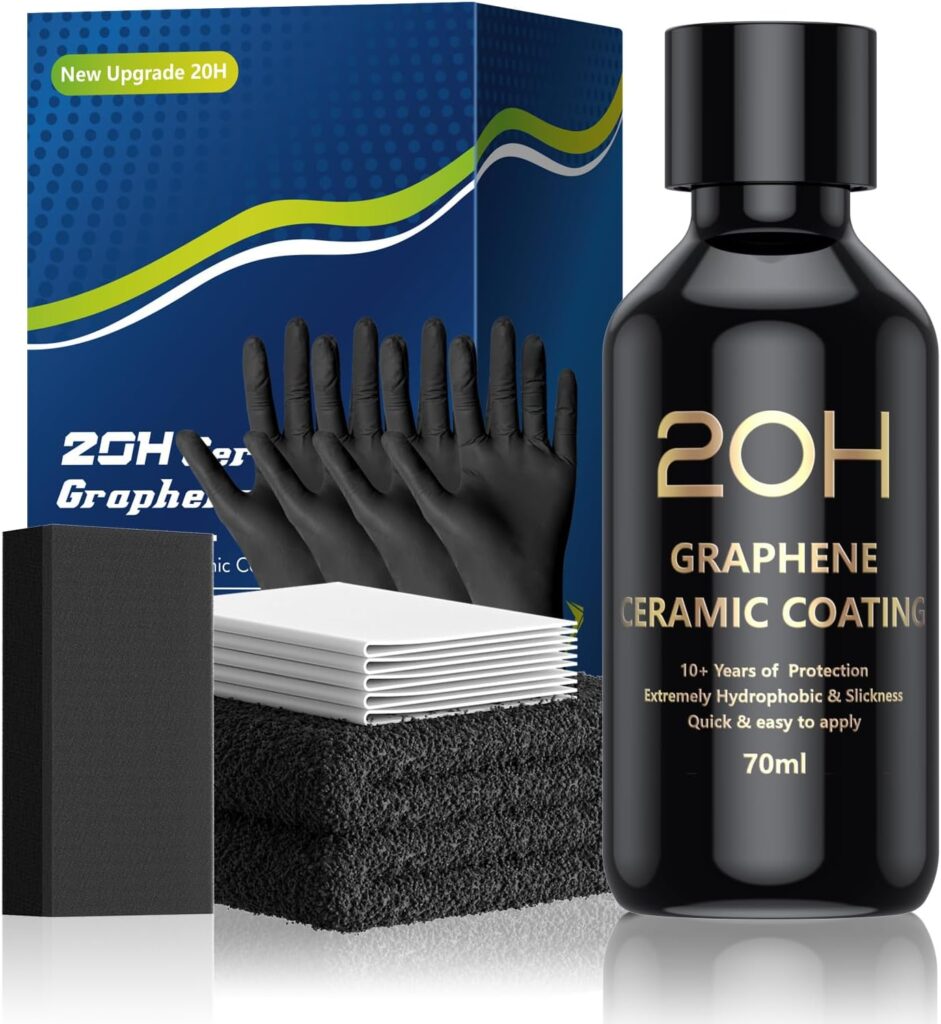
Conclusion: Maintaining a rust-free vehicle
Car rust is a common and serious problem that can affect the appearance, performance, and value of your vehicle.
However, car rust can be prevented and repaired by following some simple steps and tips.
By taking proper care of your car, using the right products and services, and implementing regular inspections, you can effectively stop car rust and keep your vehicle in good shape for a long time.
check out these blog posts:

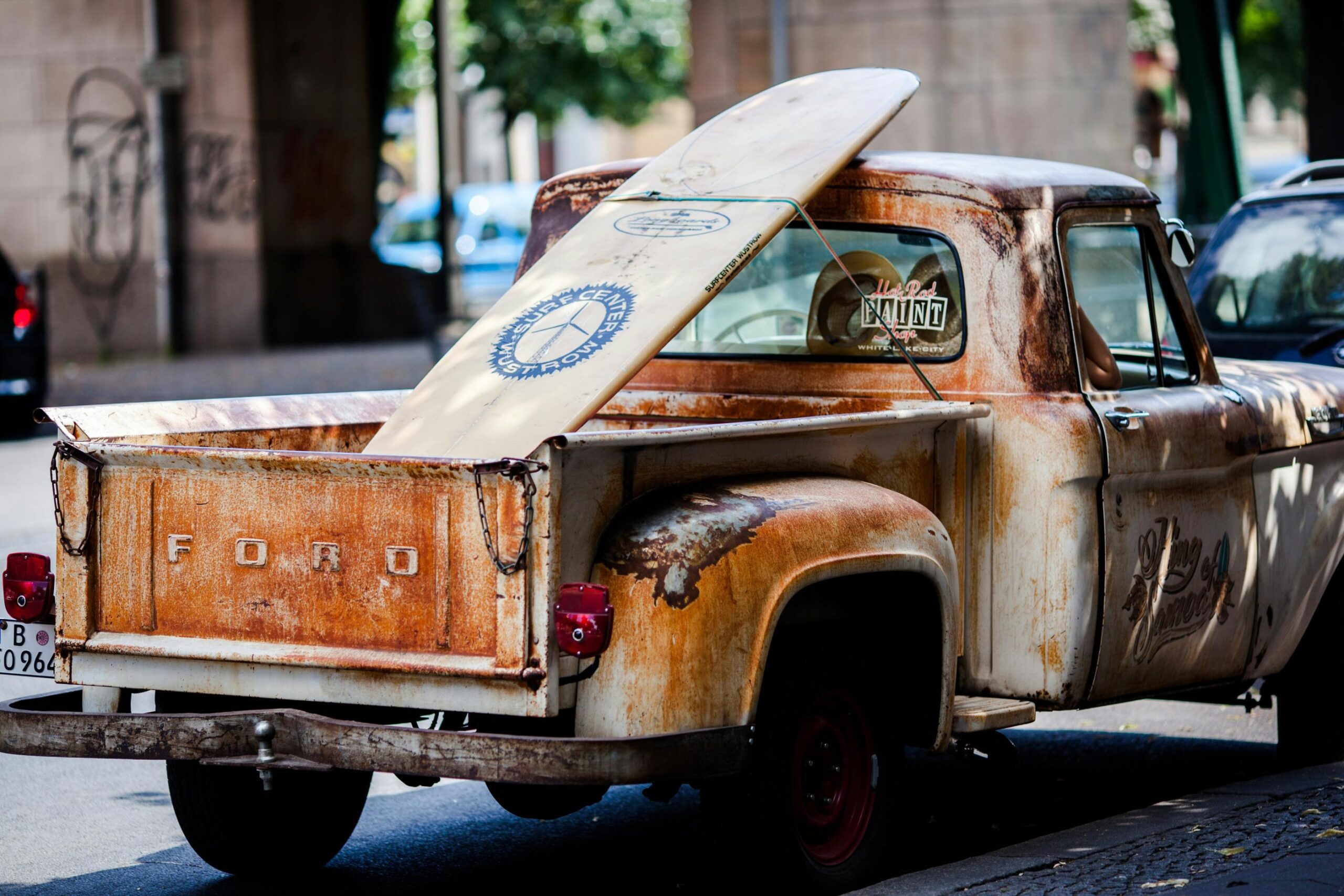
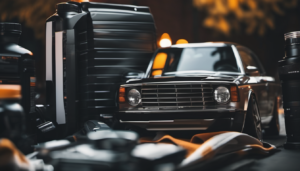

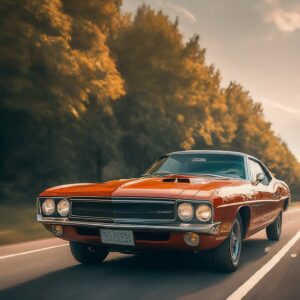
Pingback: Invest in Peace of Mind: Why Regular Car Maintenance is Your Wallet’s Best Friend